Bed bugs are some of the worst pests you could ever encounter.
Not only do they bite…
But they spread incredibly fast and are very difficult to exterminate.
They hide in places like:
- Under furniture.
- In dark cracks.
- Within piles of laundry.
so they can be hard to find.
Even if you spot and kill some of them, there are usually more to be found later.
Keep in mind that bed bugs go through 5 stages of development:
From eggs, they hatch into baby bed bugs.
(Also known as nymphs).
If you notice a baby bed bug in your home or hotel, one thing is certain – there’s a growing infestation.
It’s a warning sign that there are adult bed bugs laying eggs, which they can’t do without a regular food source.
Page Contents:
What Do Baby Bed Bugs Look Like?
Baby bed bugs look similar to their adult counterparts since no metamorphosis is involved in their development.
Their development stages only have to do with their growth and change in color.
Those 2 factors are the most notable differences between adult bed bugs and nymphs.
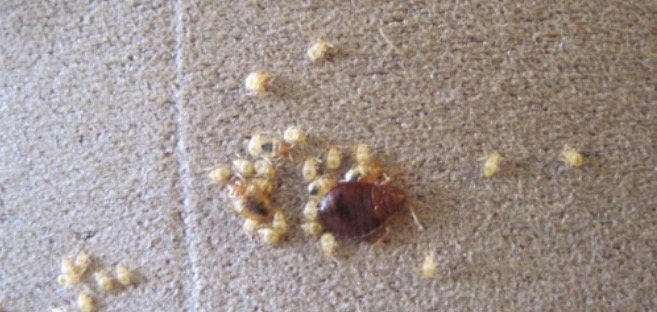
One of the most common myths about baby bed bugs is that you need a magnifier of some sort to be able to see them.
Though they’re quite small (about ¼ inch long), they can be seen with the naked eye.
What Color Are Baby Bed Bugs?
Just like the color of their eggs…
Baby bed bugs are mostly white.
That’s why it can be tough to spot them, especially if you have white sheets and white furniture.
However, that’s only just after the hatching and before the first feed.
Remember…
Baby bed bugs go through 5 stages before they become adults. Their color becomes darker with each stage.
Also, to grow and develop, baby bed bugs need to feed often.
(Hence the infamous bed bug bite).

Once they do, you can see the blood in their abdomen, because their exoskeleton is incredibly thin at first.
It’s almost as if they’re translucent. After the first feed, they begin to digest the blood, before molting.
(shedding their exoskeleton).
And growing to the next development stage (about 2 to 3 weeks).
They need to feed in order to molt, which means they have at least 5 meals before maturing. As they digest more blood, they slowly start turning brown, which is what they continue doing all through the next stages.
Upon reaching the 5th and final development stage…
They are completely brown from all the blood nutrients, just like all the other adult bed bugs.
When they feed again as adults, they get a red tint in their bodies.
The below video provides a nice visual overview of the bed bug life cycle.
How Big Are Baby Bed Bugs?
Apart from color, baby and adult bed bugs also differ in size. Baby bed bugs that have just hatched are about 1 millimeter on average (about the size of a grain of rice).
That’s why spotting them may seem like an impossible mission, especially since they’re also milky white.
Their body is oval and flat, but it slowly fills up as they feed, so mature bed bugs are fuller in size.
You can compare adults to the size of an apple seed.
If they find a blood meal soon after hatching, bed bugs can become fully grown in about 6 weeks.
Since nymphs can go without a meal for at least 2 – 3 weeks, their growth process can last a bit longer.
Pictures of Baby Bed Bugs
Here are some notable pictures of baby bed bugs relative to adults:
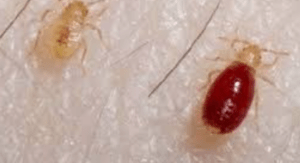
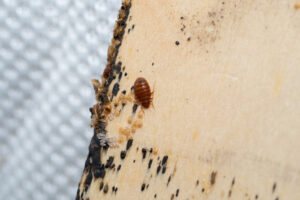
For more pictures of baby bed bugs you can view our bed bug gallery.
At this point, you certainly have an idea of what baby bed bugs look like, especially if you’ve already seen them in their adult stage.
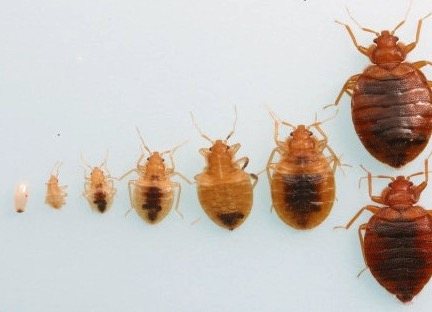
However, they don’t say “a picture is worth a thousand words” for nothing.
Bed bugs are not a pleasant sight to look at, but you should take a hard look.
After all, you need to know how to identify them if you ever see them crawling around your home or hotel room.
Here’s a picture of their development stages, where you can see how their color changes after each molting.

As you can see in this image, as bed bugs develop and grow, their color becomes darker.
Bed bugs change color with every feed as they absorb the blood. They will go from a translucent nymph…
To a reddish-brown, fully grown bed bug.
Baby Bed Bug Bites
Both adult and baby bed bugs bite using their two straw-like antennae.
Antennae 1:
Used to break the skin and inject their saliva, which contains an anesthetic that numbs the bite site. That’s why you typically don’t feel anything while a bed bug is biting you.
Antennae 2:
The second antenna is used to drink the blood. With mature bed bugs, that process usually lasts about 5-10 minutes, but it’s shorter with the babies.
Since your body immediately detects a foreign substance, the bite site swells and becomes red due to more blood coming that way.
It then becomes itchy as a result of the body’s histamine reaction.
(Histamine is a pheromone used by bed bugs to communicate).
Luckily, bed bugs don’t typically carry disease, so their bites aren’t dangerous.
However, you may have an allergic reaction and require medical assistance.
If you don’t need medical assistance, the bite marks will disappear within 2 to 3 weeks…
(for most people).
But if you don’t immediately start eliminating the source of the infestation, they’ll keep biting you.
Can Baby Bed Bugs Lay Eggs?
The short answer is no. Baby bed bugs can’t lay eggs, because they are not capable of reproduction until they are fully grown.
It’s only when female bed bugs mature that they can start reproducing.
Also, there are no family ties preventing bed bugs from reproducing. A mature female bed bug can mate with her offspring as soon as they become adults.
Bugs That Look Like Baby Bed Bugs
Many people have mistaken various insects for bed bugs, as there are some very similar bed bug look-alikes.
However…
Although they look similar, you can actually tell one from the other if you know what to look for.
Some insects that look like baby bed bugs include:
- Lice
- Booklice
- Fleas
- Mites
- Ticks
- Cockroach nymphs
- Carpet beetles
- Spider beetles
It’s best to learn what adult bed bugs look like in case you ever need to properly identify an infestation.

Do Young Bed Bugs Crawl?
All bed bugs, no matter the age, rely on finding a shelter to hide in until they go out to feed…
Which is usually at night.
Therefore, they don’t move particularly fast.
Their legs are incredibly short, so it’s difficult for them to quickly move their body. If you notice a younger bed bug, you’ll see that it crawls very, very slowly…
But that’s actually its full speed.
How to Kill Baby Bed Bugs
Stopping a bed bug infestation in its tracks requires a full-scale treatment.
Especially if you’re looking to kill bed bugs in all life stages…
Which is absolutely critical to preventing a recurrence.
For smaller localized infestations there are certain DIY methods that can help treat an infestation.
These include the following:
- Vacuuming: Using a strong vacuum with a certified HEPA filter can help remove visible bed bugs.
- Laundry: Wash/Dry all clothes on high heat.
- Insecticides: These can include chemicals such as diatomaceous earth or top bed bug killers (although be careful when using pesticides in the bedroom).

If you believe you’re experiencing a more severe infestation…
Meaning you’re consistently seeing bed bugs around the home and getting bitten on a daily basis.
You may want to try these professional treatments..
Here are our recommended options:
1. Conventional Pesticide Treatment:
This includes the application of EPA approved insecticides by a pest control professional. This method typically requires multiple treatments, but a trained professional is safer than trying to apply potentially harmful chemicals yourself.
2. Professional Heat Treatment:
This is probably the most effective treatment for the removal of a wide scale infestation. It involves heating up your home to temperatures above 120 degrees F for multiple hours. This heating method will kill bed bugs in all life stages and ones that are in hard to reach places.
The Bed Bug Nymph
In more scientific circles, juvenile bed bugs are simply referred to as “Nymphs.” They reach this nymph status directly after they emerge from the egg.
The time frame it takes nymphs to mature into adult bed bugs depends on a couple of factors:
The reliability of a food source:
Though adult bed bugs can go a long period of time without feeding, nymphs need to feed at least once per week to help them develop appropriately. As mentioned earlier in this article, each stage of the development process is anywhere from 2 to 3 weeks long.
The temperature of the living area:
Bed bugs flourish in a stable environment that stays at room temperature consistently. A nymph will have a hard time growing if temperatures are not adequate.
That is anything below 55 degrees F or above 100 degrees F can either lengthen or completely inhibit the bed bug lifecycle.
In an established infestation, bed bug nymphs can represent a large percentage of the overall bed bug population.
Bed Bug Larvae
Bed bug larvae are small worm-like insects that are the immature form of a bed bug. As with nymphs, larvae are typically whitish-yellow in color and measure approximately 1 to 1.5 millimeters long. Their bodies are segmented and they do not have wings. It is possible for bed bug larvae to live for months without eating blood.
They typically hatch from eggs that are laid by adult bed bugs.
Once they have hatched, the larvae will quickly reach the nymph stage and molt several times before reaching adulthood.
Do Bed Bugs Bite Human Babies?
Often times babies can be extra vulnerable to bed bug bites because they don’t move around as much as adults do. Young babies can also be more attractive to bed bugs because these insects cannot move around human hair very easily.
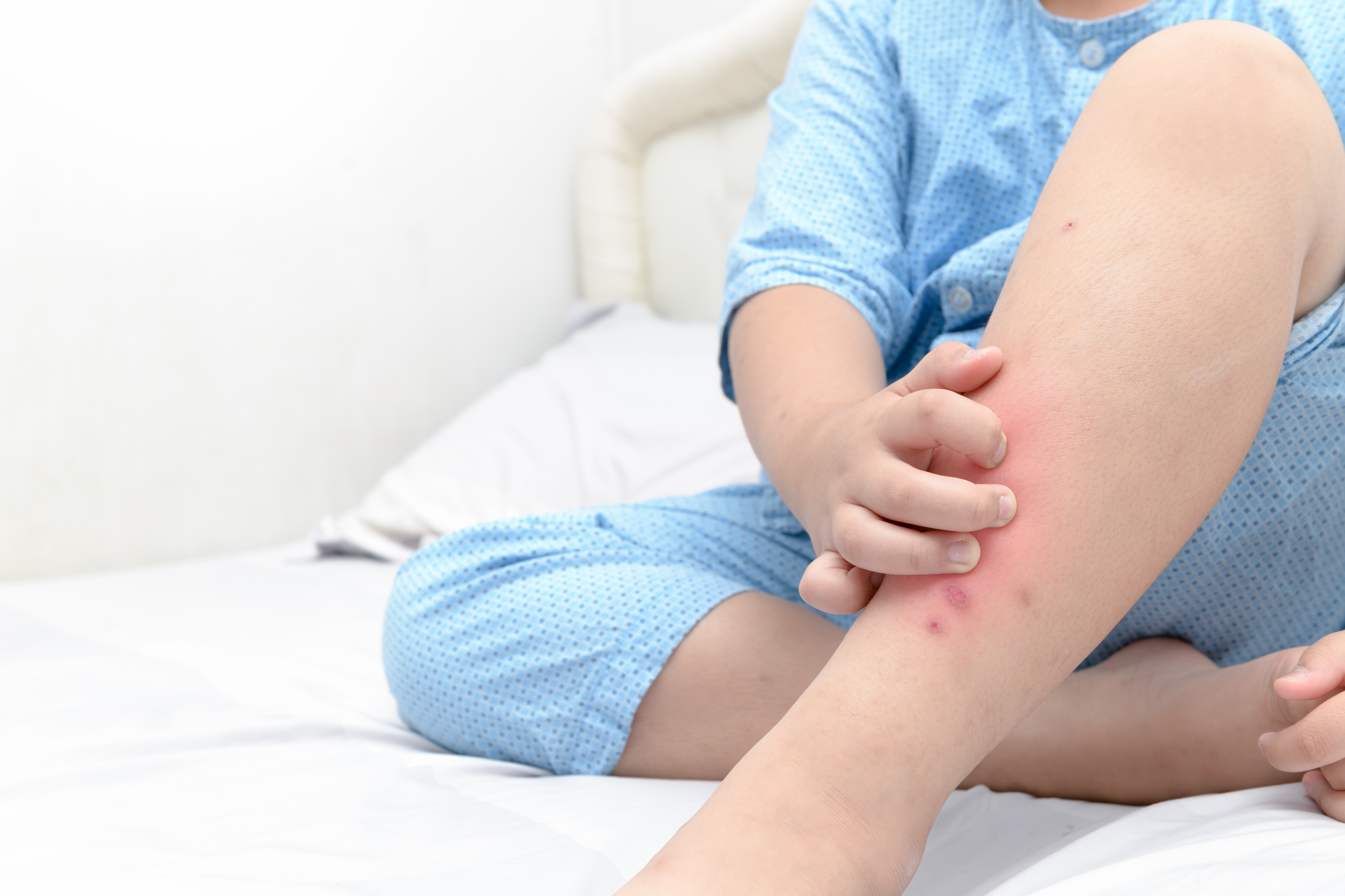
If you suspect your child is being bitten by bed bugs you should apply treatment immediately.
Here are some common treatment methods for bites on children:
- Utilize antiseptic creams.
- Cleaning the area that has been bitten with soap and water.
- Apply an ice pack if the bites look irritated.
But when should you consult a doctor?
Bed bug bites can get worse if not treated properly. Scratching for example, can lead to swollen or liquid-filled scars that will require medical attention.
Consult a doctor if….
- The size of the bites grows larger.
- If the baby develops an intense fever.
- If the baby is having trouble breathing.
Even if the symptoms are mild the bites should go away over time. If after a few weeks, the bites persist on your child’s skin, you should consult with a doctor immediately.
For more detail, you can view the top 5 health risks of bed bugs to children.
File a Bed Bug Claim
If you fall victim to a bed bug infestation due to the negligence of your landlord, or a hotel, motel or resort you stayed at…
Our bed bug specialists can assist in connecting you with a lawyer.
We can assess your situation to determine if you may be able to seek monetary compensation.
We can help you learn if you have a case, so we can potentially offer you assistance with a bed bug lawsuit.
Get in touch today to see if you have a case, and we’ll let you know if our attorneys can provide you with the right legal guidance!
You can submit your case here or give us a call at (855) 733-9217






Very very interesting. I’m a motel owner who has unfortunately suffering from multiple bed bug infestations in my room and it’s putting me out of business. I have tried many many methods but nothing seems to work. I do see baby bed bugs around along with adults which i think means I have a serious infestation. Are there any more creative methods I should be using?
Pingback: What do baby bed bugs look like? | Bedbug Detected
I got bite by bed bugs in a hotel and I am allergic to them and had a allergic reaction to my bites.